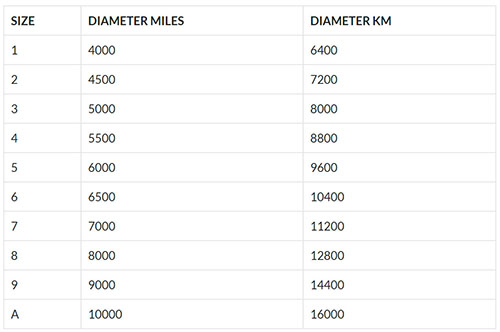House Rules
Posted: Fri Jun 21, 2024 3:30 pm
PLANETARY SIZE
A problem with the random generation of worlds in Traveller is that for small worlds (where size < 4) is that these worlds might get an ordinary breathable atmosphere. This is a problem, since the minimum molecular weight retained for a planet shouldn’t allow that. This problem leads to silly explanations like the one in both the GURPS and Mongoose Sword Worlds modules where a planet (Enos) is made of Osmium. Other explanations might be terraforming by the ancients.
These explanations might explain how a few (very unique) worlds got their atmospheres, but it seems unlikely that these explanations can explain every world equal or smaller than size 3 with an atmosphere equal or greater than 2. In an average sector with standard stellar density there are about 80 such worlds. (In the Spinward Marches, there are 73 worlds with this problem.)
Instead of explaining every world or changing the UWP, I will use this size table.

As can be seen is this table, the problem is solved by making the smallest inhabited planets big enough to retain a breathable atmosphere. Size 1-6 worlds are now larger than what the system normally calls for, but 7+ remain unchanged. This allows for more realistic atmospheric results.
A problem with the random generation of worlds in Traveller is that for small worlds (where size < 4) is that these worlds might get an ordinary breathable atmosphere. This is a problem, since the minimum molecular weight retained for a planet shouldn’t allow that. This problem leads to silly explanations like the one in both the GURPS and Mongoose Sword Worlds modules where a planet (Enos) is made of Osmium. Other explanations might be terraforming by the ancients.
These explanations might explain how a few (very unique) worlds got their atmospheres, but it seems unlikely that these explanations can explain every world equal or smaller than size 3 with an atmosphere equal or greater than 2. In an average sector with standard stellar density there are about 80 such worlds. (In the Spinward Marches, there are 73 worlds with this problem.)
Instead of explaining every world or changing the UWP, I will use this size table.

As can be seen is this table, the problem is solved by making the smallest inhabited planets big enough to retain a breathable atmosphere. Size 1-6 worlds are now larger than what the system normally calls for, but 7+ remain unchanged. This allows for more realistic atmospheric results.